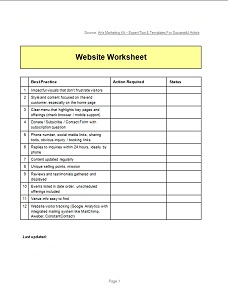How to make your website work for you and your patrons
Your website is a key ingredient of your communication plan. Follow our straightforward list of must-dos to ensure that your website is useful for your patrons and helps you achieve your key goals – connecting with your customers and fans, and achieving sales and donations.
-
Use impactful visuals… with the overall user experience in mind
 Strong visuals help gain and keep your readers’ attention, and make it easier for them to imagine the experience you are trying to market to them. However, don’t overdo it. Less is often more, and a few well chosen photos will leave a stronger impression than pages that display a lot of images. And no matter what your artistically inclined web designer tells you, having to watch several seconds of a blurry video before each page loads results in a very frustrating user experience.
Strong visuals help gain and keep your readers’ attention, and make it easier for them to imagine the experience you are trying to market to them. However, don’t overdo it. Less is often more, and a few well chosen photos will leave a stronger impression than pages that display a lot of images. And no matter what your artistically inclined web designer tells you, having to watch several seconds of a blurry video before each page loads results in a very frustrating user experience. -
Focus on your patrons
Remember to focus on the perspective of those people who matter most to you – the patrons and fans who buy your offerings and support you with their donations. There are lots of arts organizations whose home page contains a list of all the important venues that have shown their work over the years. That information may be useful to boost your credibility with presenters, but it does not make for an appealing read. It should therefore not be positioned on your home page. Your main description, as well as your other content, should focus on what is most relevant to your patrons: what are the different ways they can experience your work and why will they enjoy them.
-
Make it easy to access key content, and highlight your offerings
Use a simple menu structure with clear labels that anyone can understand and that highlight your key pages and offerings. For example, if you teach classes and offer performances for conferences, then make sure that visitors find out about them through a relevant option on the menu bar.Instead of displaying the full offering descriptions on your own site, you may want to use a booking site like GoSeeDoArts for your detailed offering pages. In that case, you benefit from an integrated booking and payment mechanism, additional visitor traffic and cross-links with your main site. Wherever your portfolio pages are located, follow our tips for writing offering descriptions that sell.Remember to check your website from time to time in the latest browsers. A menu bar that looked great a few years ago may not behave as expected for all your visitors today. Also test that your site is usable on tablet computers and smartphones. If your dropdown menu bar does not function on these devices and you are not ready to have it redesigned, you can use simple workarounds, like providing a set of links in the footer or including related links within your main pages.
-
Encourage people to donate and sign up to your mailing list or newsletter
The links or buttons for donating and for joining your mailing list should be shown prominently on your site’s common menu bar.
Use a contact form rather than providing your email address, and ask in that form whether you are allowed to add the person’s email address to your mailing list. Growing your mailing list is one of your key objectives, so that you can contact fans, customers and prospects with your marketing messages on an ongoing basis. Don’t forget to give people a good reason for handing over their details. You may promise them a simple-to-administer giveaway, like access to a special video. In your sign-up form take the opportunity to gather some background information about them for more targeted messaging. Since every additional question makes is less likely for people to sign up, limit your questionnaire to asking for their name and address and their interest in your work.
-
Invite visitors to get in touch, make a purchase and spread the word
Give people the impression that you are very approachable, and invite them to contact you. In addition to offering a contact form with friendly wording on it, display a contact phone number and links to your social media accounts.
On your portfolio pages it is not enough to display a list of your offerings. Encourage people to take action by providing clear instructions and links or buttons for making a purchase or sending you an inquiry. Remind them to spread the word about your offerings via a set of social sharing tools.
-
Reply to inquiries within 24 hours
Be diligent about checking your messages regularly, and reply with a short (possibly automated) acknowledgment if you don’t have the time for a proper answer. Don’t risk losing a sale because you are too slow to reply. Your prospects are probably looking at other alternatives as well, and you don’t want them to assume that their inquiry on your site has disappeared into a black hole.
If prospects leave their phone number, always try to give them a call. Speaking to them in person will significantly raise your chances of closing a deal.
-
Keep your site current
Your site needs to look relevant and trustworthy to people. Seeing last year’s schedule of events and projects that “will be launched in 2011” leaves a negative impression. Put reminders into your calendar to update your website regularly, and use a content management system that allows you to make changes yourself rather than having to rely on somebody else for support.
-
Present your unique selling points and your mission
Tell people why your work is special and what you aim to achieve with your projects. Your goals may represent an important connection point with potential patrons and supporters.
-
Show reviews and testimonials
Testimonials are a great way of fostering closer connections with your fans and patrons, and they serve as important social proof for new customers. Either invite patrons to post their feedback directly on your website, blog or Facebook page, or ask them after an event to send it to you via email. In addition, you should of course bolster your credibility by displaying reviews and praise from trusted sources, like newspapers or major websites, on your site.
-
List your events in date order
People want to find out right away whether you offer something on the dates that they care about. Don’t forget to mention the unscheduled tailored offerings that you will make available based on demand.
-
Make it easy to find the venue address
Ideally display the venue and its address or a link to it on the home page so that people on the go can find it quickly. It is also a good idea to include some helpful information on the venue, like how to get there, where to park and where to eat in the area, to simplify the organization of your patrons’ visit.
-
Track new and repeat visitor traffic and your visitors’ pathways
Google Analytics combined with an integrated mailing system like MailChimp, Aweber or ConstantContact provides you with the necessary statistics to check the impact of your promotional efforts and the effectiveness of your website design and wording.
Examples of nicely designed and well worded artist websites:
> Amalgamate Dance Company
> Gallim Dance
<< Previous: Communication Plan
>> Next: Offering Descriptions
Related pages:
> Persuasion Tactics Artists Need To Know
> The Secrets Of A Successful Communication Plan For Artists
> Create A Diverse Portfolio To Increase Your Income
> How To Write An Offering Description That Sells

